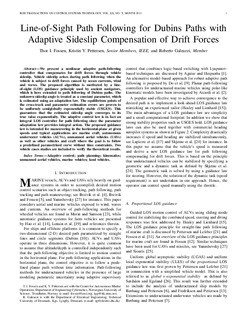Line-of-Sight Path Following for Dubins Paths with Adaptive Sideslip Compensation of Drift Forces
Journal article, Peer reviewed
Permanent lenke
http://hdl.handle.net/11250/280167Utgivelsesdato
2014Metadata
Vis full innførselSamlinger
Sammendrag
We present a nonlinear adaptive path-following controller that compensates for drift forces through vehicle sideslip. Vehicle sideslip arises during path following when the vehicle is subject to drift forces caused by ocean currents, wind and waves. The proposed algorithm is motivated by a lineof-sight (LOS) guidance principle used by ancient navigators, which is here extended to path following of Dubins paths. The unknown sideslip angle is treated as a constant parameter, which is estimated using an adaptation law. The equilibrium points of the cross-track and parameter estimation errors are proven to be uniformly semiglobally exponentially stable (USGES). This guarantees that the estimated sideslip angle converges to its true value exponentially. The adaptive control law is in fact an integral LOS controller for path following since the parameter adaptation law provides integral action. The proposed guidance law is intended for maneuvering in the horizontal-plane at given speeds and typical applications are marine craft, autonomous underwater vehicles (AUVs), unmanned aerial vehicles (UAVs) as well as other vehicles and craft where the goal is to follow a predefined parametrized curve without time constraints. Two vehicle cases studies are included to verify the theoretical results.
Beskrivelse
This is the author’s final, accepted and refereed manuscript to the article.
